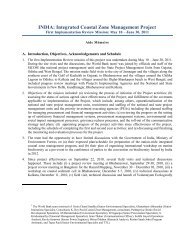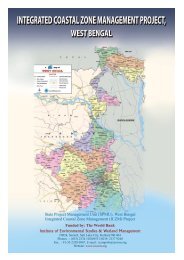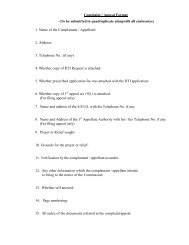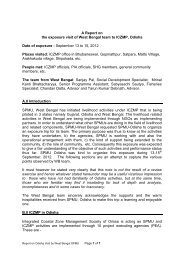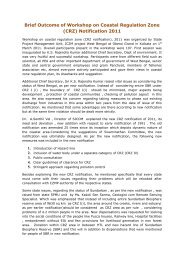Cyclone and Storm Surge - Iczmpwb.org
Cyclone and Storm Surge - Iczmpwb.org
Cyclone and Storm Surge - Iczmpwb.org
You also want an ePaper? Increase the reach of your titles
YUMPU automatically turns print PDFs into web optimized ePapers that Google loves.
3.2<br />
a storm surge caused by a tropical cyclone. Under such a condition, when a lot of water needs to be<br />
discharged off from the city, the outfalls are found to be blocked of by a high water level of the<br />
creeks. This renders the city waterlogged for many hours at a stretch at times. In order to underst<strong>and</strong><br />
the full system of Kolkata’s urban drainage <strong>and</strong> the reason for this kind of drainage congestion, it is<br />
necessary to go back in history <strong>and</strong> review the city’s drainage system from the beginning. The<br />
authors of this project report are grateful to Dr. S. S. Ganguly, retired Superintending Engineer,<br />
Irrigation <strong>and</strong> Waterways Department, Government of West Bengal for permitting the use of the<br />
following descriptions about Kolkata <strong>and</strong> its drainage proposals from the paper Ganguly (2006).<br />
3.2 Physiography <strong>and</strong> the drainage systems planned during the formative years of Calcutta<br />
(Kolkata)<br />
The physiographic setting of Kolkata (22° 34' N, 88° 22' E), both at the time of its foundation as well<br />
as in the present day, is dominated by the me<strong>and</strong>ering Hooghly river. Along the left bank of the river,<br />
which is also the western boundary of the city, there stretches a narrow belt of comparatively high<br />
natural levee, which varies in 2 to 5 kilometers. As a consequence of this natural levee general slope<br />
of the l<strong>and</strong> was from west to west. But during the initial years, drainage of the city was directed<br />
westwards to the Hooghly-river. A small creek, the Gobindapur creek was utilized. The creek ran<br />
from the Salt Lakes in the east via present day Beliaghata, Sealdah, Creek Row, Dharmatolla <strong>and</strong><br />
Government Place (North) before draining into the Hooghly below the Princep Ghat. This creek also<br />
served as a navigation channel <strong>and</strong> it is reported that Charnock used to collect toll from the boats<br />
moving in <strong>and</strong> out of the creek. But in course of a furious hurricane on Sept. 30, 1737 when 15<br />
inches (38.10 cm) of rainfall occurred in just 5 hours, 20,000 ships, barks, sloops, boats, canoes etc.<br />
were destroyed, the creek was rendered almost useless for navigation. In 1742, a seven mile long<br />
ditch was excavated along the present alignment of the Circular Road (APC Road & JPC Road) to<br />
keep the Maratha marauders at bay. This ditch aptly called the Marhatta ditch sounded the death<br />
knell of the creek. The natural <strong>and</strong> man made interferences took their tool on the not so efficient<br />
drainage system of the city. Very soon drainage congestion resulted <strong>and</strong> prolonged water logging<br />
was the order of the day. The consequences were so severe for the health <strong>and</strong> hygiene of the city<br />
that then Governor General Lord Wellesley (1766 - 1842) had to intervene. His now famous minutes<br />
of June 16, 1803, which recommended radical change in the direction of the principal channel of the<br />
Public Drains, read as follows:<br />
"The defects of the climate of Calcutta, during the part of the rainy season, may indeed be ascribed<br />
to the state of the drains <strong>and</strong> water courses <strong>and</strong> to the stagnated water remaining in the Town <strong>and</strong> its









